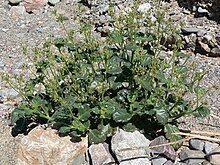Aliciella latifolia (formerly Gilia latifolia),[1] also known as broad-leaved gilia, is a foul smelling annual plant in the Phlox family (Polemoniaceae) found in deserts of the southwestern United States.[2][3]: 114
| Aliciella latifolia | |
|---|---|

| |
| Aliciella latifolia in Furnace Creek Wash, Death Valley, California | |
| Scientific classification | |
| Kingdom: | Plantae |
| Clade: | Tracheophytes |
| Clade: | Angiosperms |
| Clade: | Eudicots |
| Clade: | Asterids |
| Order: | Ericales |
| Family: | Polemoniaceae |
| Genus: | Aliciella |
| Species: | A. latifolia
|
| Binomial name | |
| Aliciella latifolia (S.Watson) J.M.Porter
| |
| Synonyms | |
|
Gilia latifolia S.Watson | |
Habitat and range
editIt grows in the eastern and northern Mojave Desert and Colorado Desert.[2] It is common in desert dry washes and on rocky hillsides below 2,000', and in creosote bush scrub, especially where there is desert varnish.[2]
Growth pattern
editIt is an annual growing from 4" to 12" tall.[2]
Leaves
editLeaves are simple, leathery, and ovate to round, with toothed margins sometimes[citation needed] tinged with pink to red.[2] Leaves are unusual with broad holly-like leaves, compared to its relatives which have pinnately divided leaves.[3]: 114
Flowers
editFlowers have five sepals, five petals fused into a narrow, funnel-shaped, corolla tube. Its five stamens alternate with the lobes of the corolla.[citation needed] Flowers occur in a cluster at the end of the stems.[2] The outside of the corolla is pale pink to tan, and the inside is pink to bright red, with stamens of unequal length that barely protrude past the corolla.[2]
Fruits
editFruits are capsules with 3-compartments, each having many reddish-brown seeds.[2]